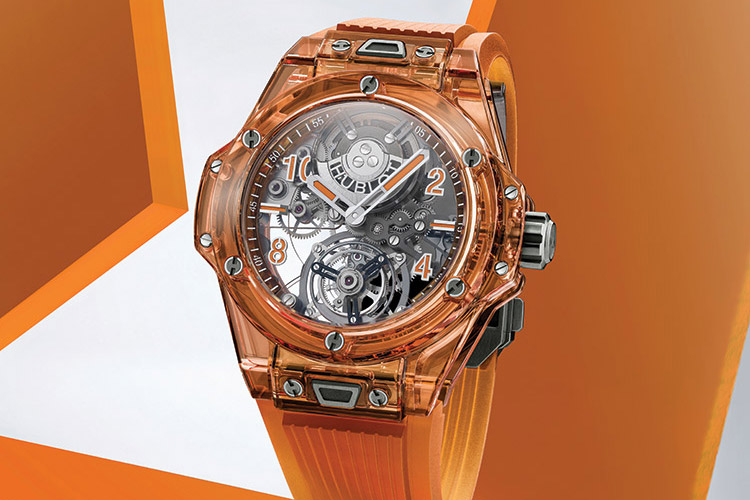
Hublot hosted its 2021 Novelties Viewing in Dubai recently and we caught up with David Tedeschi Regional Director Latin America & Caribbean, Middle East & Africa, who talks of ceramic, sapphire watches… and art partnerships. Read on for the details on Hublot’s collections this year and the thinking behind them
Why did you choose ceramic as a material for the Integral?
We first used ceramic in our original Big Bang model in 2005, as a combination of ceramic and steel or ceramic and gold. It is a material that has been developed and used a lot since then in our collections. Now Hublot is one of the most well-known watch manufactures for using ceramic in watches and that is considered part of our DNA. One of our biggest achievements has been the industrialisation of our manufacturing process so that we are able to manufacture our ceramic cases and bracelets in-house, which is a huge plus point.
When we launched the Big Bang Integral collection in Dubai last year – it was completely new for us to have a Big Bang Unico case fully integrated with the bracelet – we presented three models: one in King Gold, one in titanium and one in All Black ceramic with a fully ceramic bracelet and case. We decided to develop ceramic in different colours and integrate them in this collection; thus, the four new references, but three new colours of ceramic in this collection.
The fourth edition is the Black Magic version; it is an evolution of the old Black version but on a non-limited basis. We also came up with 3 colours of ceramic – full white ceramic, full blue ceramic, both of which are also used in our other collections, and then we have the completely new grey ceramic.
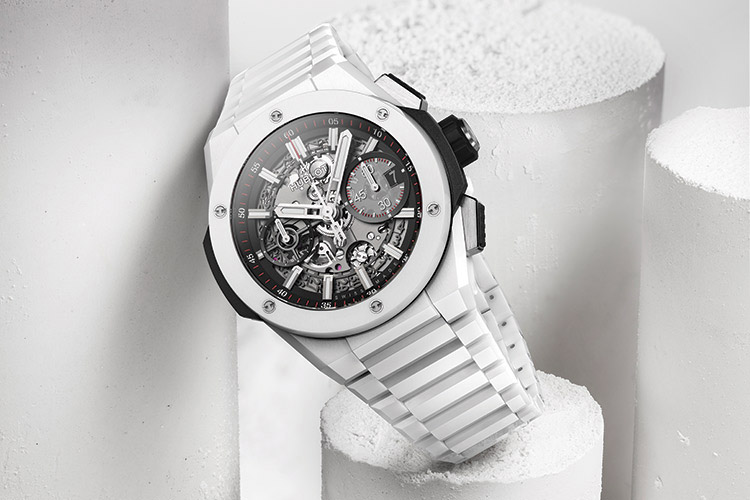
Did Hublot anticipate this kind of feedback for the Big Bang Unico Integral Ceramic?
Yes, of course. Because Ceramic is a predominant and important material in our collection, while we do listen to the feedback, we are not limited in our creativity. I don’t think I have seen any watch brand use this type of ceramic colours before, so this is something that we are working on and that you will see more and more in our future collections.
Hublot normally does not do grey colours, so why does this year’s collection have a grey coloured watch?
This is the first time we are doing a grey watch, especially in ceramic; but it is not unusual for a watch because watches in silver and titanium have this kind of look. Of course, this looks completely different as you can make out at first glance that this is ceramic and not metal. Achieving new colours and bringing new colour choices for our customers is what is important to us, as is diversification. Yes, grey is an unusual colour for us and we will be using it more often in the future.
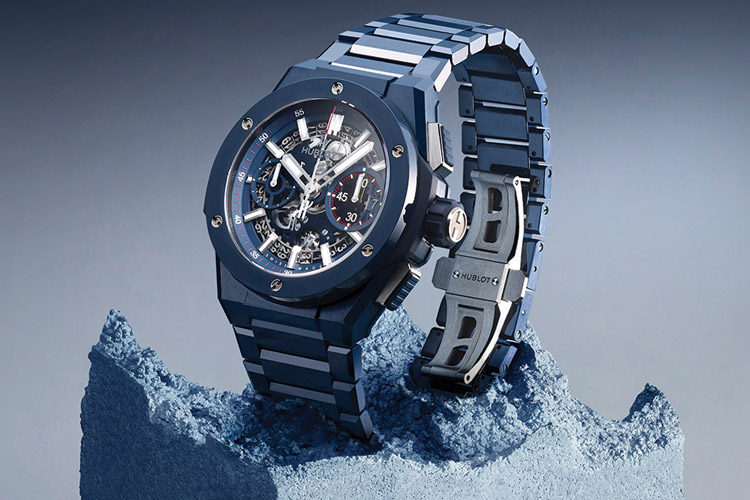
Which colour was the most popular in terms of the feedback?
It is always black; you can’t go wrong with black. Black goes with all colours and materials; it is elegant and yet entrepreneurial. When you go for different colours in ceramic, it is extravagant. All three watches can be everyday watches, but it may be more difficult to match a fully blue or fully grey ceramic watch than it would be to match a fully black ceramic one.
Can you tell us about the movement of the Tourbillon Automatic?
It is a fully in-house manufacture movement; this is the first time we are doing an automatic tourbillon. We have a micro-rotor at 12 o’clock on the dial side and not the caseback. We don’t have the Hublot logo on the glass like in other watches; the logo is directly incorporated on the micro-rotor, which is made of white gold to enable the winding of the watch properly. This movement is really a piece of art, fully skeletonised with three bridges made of sapphire to deliver more transparency. Another watch that I would like to highlight is the Big Bang Tourbillon Automatic Orange Sapphire – a limited edition of 50 watches only.
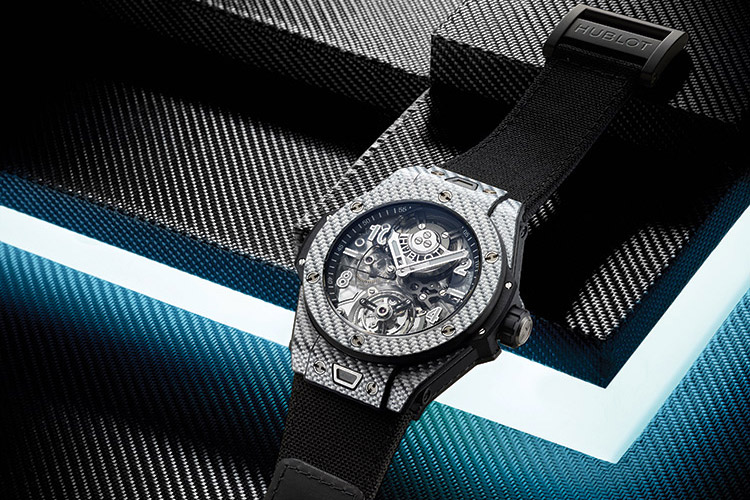
Having our own in-house sapphire production allows us to play and create different colours; the Orange Sapphire is a world-first as it has not been done before. It is much more eye-catching and beautiful in real life. Its colour is unusual and beautiful. The combination of the translucent orange sapphire case and fully skeletonised movement makes it seem as if the movement is flying inside the watch.
How many sapphire watches is Hublot producing in a year now?
That is difficult to say, but a few thousand pieces. Last year, we introduced the Big Bang Unico Sapphire re-edition of the 45mm first sapphire watch that we launched. We also have one in 42mm; this edition is of 500 pieces and we also have a number of limited editions in our collections made from sapphire. For instance, we have the Spirit of the Big Bang Saxem, which is a limited edition of 100. I would say that we make around 1,000-2,000 pieces a year, which is already a huge number especially when you consider the complexity of processes involved in the making of sapphire pieces, as well as the time. It takes 50 times longer to produce a sapphire watch than it does to produce a steel or titanium one. The complexity and the time involved do not permit us to produce more than this.
How much time did the Tourbillon Automatic movement take – from its inception, R&D, till final production?
When we talk about the creation of a completely new movement, it takes years. Hublot is very well-known for developing movements very fast, and it took us a little bit more than two years to develop this movement. The difference between developing a new movement and creating a new case is that the whole assembly process is involved. When you launch a new movement, you have to give guidelines to the watchmaker to be able to assemble it because the assembly process for a tourbillon movement takes a longer period of time than a regular chronograph movement.
Also, each watchmaker working on a complication movement at Hublot is building the watch from A to Z by himself; it does not go to different departments in a production line. And then there is the testing of the movement, the proper battery of tests to enable certification. That is why the creation of a new movement is much more difficult than just changing the material of a case.
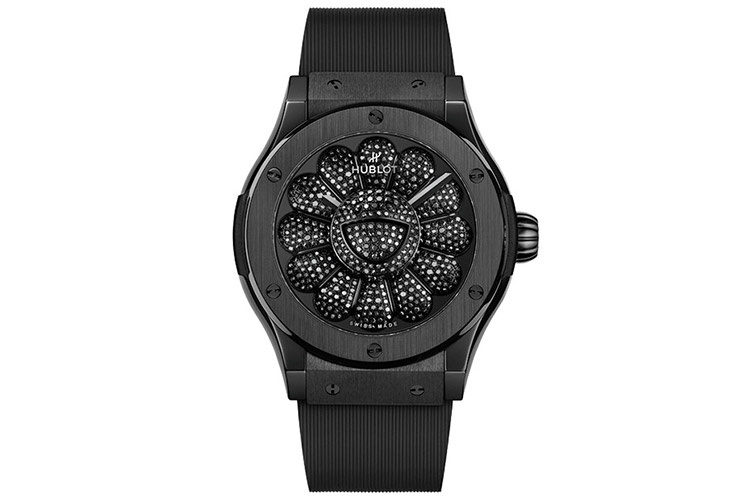
The movement was completely done in-house?
Absolutely, the whole movement was conceptualised and created in-house at our manufacture.
You have unveiled Classic Fusion Orlinski; do you think there is any need for a ceramic edition for the ladies?
Ceramic is an amazing material; this material is so hard it will remain the same with the passage of time. When you buy a fully integrated Big Bang Unico Integral and clean it after years, it will still look the same as it did when you unboxed it. Ladies may not be as keen as men to buy technological material, but Hublot customers are different from customers of other watch brands and that is what they like. The Orlinski is an amazing piece and is a unisex model; it is a 40mm case and is big compared to any classical watch, and is one of the strongest models in the ladies’ collection at the moment. For the first time, we are also making the dial fully ceramic. We are using the same ceramic that we used on the case, but when we used on the dial, it has resulted in a beautiful 3D effect of all the angles that have continued from the case to the dial.
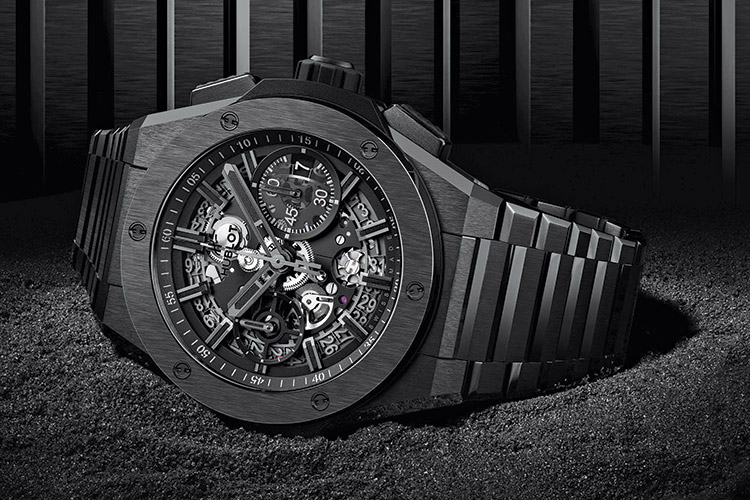
In the past few years, there has been a very big push towards the arts in Hublot; will this continue?
Definitely yes; we have announced one of our biggest partnerships this year with the new limited edition Classic Fusion Takashi Murakami. Art is very important for us because we are art, we understand art, and we transform art into our vision as well. We have had partnerships with Shepard Fairey and Romero Britto; we have an ongoing partnership with Maxime Plescia-Büchi and Richard Orlinski.
We have now unveiled a partnership with Murakami, who currently is one of the most famous artists. We weren’t the only brand looking to engage with him, but we are the only watch brand that succeeded. Things are completely different in this watch; we are using a Unico movement in a Classic Fusion case – a first for us. We have the smiling flower – Murakami’s most famous artwork – completely integrated into the watch. The flower is moving inside the dial; the actual dial itself is the flower and it turns whenever you move your wrist. It is not actually connected to the movement, so it is not winding the movement on the dial side; it is purely decorative. The centre of the flower is on top of the glass and not inside the movement. Murakami wanted to do it that way to bring out the best 3D effect. The crown has also been changed. We are doing only 200 watches, out of which 100 is allotted for Japan, and I expect it to be a great success. I have been seeing it since its conception and I have fallen in love with it.
